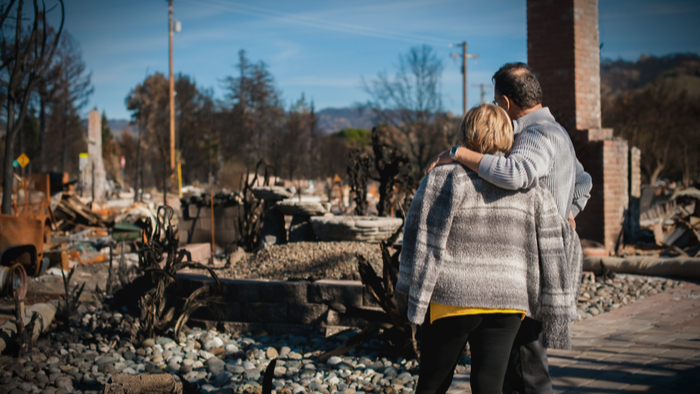救灾与恢复
概述

灾难发生后,世界各地的社区都面临着短期和长期的挑战,无论是野火、飓风还是其他悲剧。捐助方可以通过采纳一项战略,包括长期承诺、注重建设有复原力的社区和支持在危机中受到最严重打击的有色人种社区.书签这个页面;它是你学习、联系和采取行动的跳板。
要知道什么
阅读策划的文章,帮助你成为一个更有见地的给予者。
谁知道
找到经过审查的顾问,学习网络,合作基金和中介机构,以及研究提供者。
如何给
从一系列经过审查的捐赠机会中选择。
去哪里
发现符合你兴趣的活动和志愿者机会。
The Center for Disaster Philanthropy (CDP) is hosting a webinar to highlight the different ways funders and NGOs have used data to inform grantmaking, highlight needs and generate disaster funding. We will also share how CDP uses data in developing our educational resources.<\/p>\r\n
We will explore several community-level data sources and discuss the challenges of collecting, analyzing and sharing information. We will also highlight the work of innovative grantee partners that can help communities and funders create timely responses, even amid a disaster. At the end of the webinar, funders will:<\/p>\r\n\r\n
- \r\n \t
- Have an increased understanding of data sources and how this is useful for decision-making.<\/li>\r\n \t
- Develop an enhanced understanding of what is available to guide their giving.<\/li>\r\n \t
- Build a heightened commitment to collect, analyze and share information.<\/li>\r\n<\/ol>\r\n
While primarily aimed at funders, it may also be of interest to emergency managers, academics, disaster responders and NGO staff interested in or working on disasters and other crises.<\/p>\r\n
Speakers:<\/strong><\/p>\r\n\r\n
- \r\n \t
- Cari Cullen<\/a>, Director, CDP Midwest Early Recovery Fund<\/li>\r\n \t
- Andrew Schroeder<\/a>, PhD, Vice President of Research and Analysis, Direct Relief<\/li>\r\n \t
- Shao-Chee Sim<\/a>,\u00a0PhD, Vice President of Research, Innovation and Evaluation, Episcopal Health Foundation<\/li>\r\n<\/ul>","url":"\/\/www.hbhuluo.com\/event\/data-to-drive-decisions-how-can-research-inform-philanthropic-giving","date_created":1647356086,"image":null,"heading":"","host":"Center for Disaster Philanthropy","start_date":"2022-04-14 14:00:00","end_date":"","_start_date":1649944800,"_end_date":0,"timezone":"ET","link":"https:\/\/us02web.zoom.us\/webinar\/register\/WN_Id7GaoxLQ326aN6UvI2Rnw","link_text":"Register","is_online":true,"is_free":true,"price":null,"type":"Webinar","address":{},"category":{"human-services":"Human Services","region":"Region","north-america":"North America","disasters":"Disasters","human-services-human-services":"Human Services (Other)","scientific-research":"Scientific Research","research":"Research","philanthropy-research":"Philanthropy Research"},"categories":[{"id":54,"name":"Human Services","slug":"human-services"},{"id":110,"name":"Region","slug":"region"},{"id":111,"name":"North America","slug":"north-america"},{"id":253,"name":"Disasters","slug":"disasters"},{"id":33086,"name":"Human Services (Other)","slug":"human-services-human-services"},{"id":176565,"name":"Scientific Research","slug":"scientific-research"},{"id":176571,"name":"Research","slug":"research"},{"id":176572,"name":"Philanthropy Research","slug":"philanthropy-research"}],"_categories":["human-services","region","north-america","disasters","human-services-human-services","scientific-research","research","philanthropy-research"],"_tags":[],"_geoloc":{"address":"","lat":"0","lng":"0"}}]" gtm-see-all-class="gtm-topic-events-see-all" gtm-link-class="gtm-topic-where-" color="summer" api-type="events" categories="disasters" primary-category="disasters" :component-lang="{ allLink: '//www.hbhuluo.com/search/events?query=disasters', noResults: 'to explore all events.', noResultsLink: '//www.hbhuluo.com/www/search/events', }">
- Andrew Schroeder<\/a>, PhD, Vice President of Research and Analysis, Direct Relief<\/li>\r\n \t
- Cari Cullen<\/a>, Director, CDP Midwest Early Recovery Fund<\/li>\r\n \t